Famous for a rich avifauna, there are 488 bird species in Oklahoma, according to the Oklahoma Ornithological Society’s Bird Records Committee (OBRC)!
Examples of nocturnal birds in Oklahoma include the common nighthawk, American woodcock, black-crowned night heron, barn owl, northern mockingbird, and many others.
Do some of them sound familiar? Let’s jump in and see what each of these looks and sounds like!
Table of Contents
Night Birds In Oklahoma
1. American Woodcock

- Scientific Name: Scolopax minor
American woodcocks are elusive birds found in eastern and central Oklahoma, active at dawn and dusk for around 45 minutes after sunset and before sunrise. They are common in fields near young forests, especially those with scattered cover, and powerline cuts are great places to find them.
These birds are tough to spot due to their nocturnal habits, camouflaged colors, and low-key behaviors.
You can identify them by their unique “peent” call from the ground or the twittering sound in the air.
American Woodcock Call | Source: Jonathon Jongsma, CC BY-SA 3.0, via Wikimedia Commons
Read More: What birds can you hear at night in Massachusetts?
2. Wilson’s Snipe
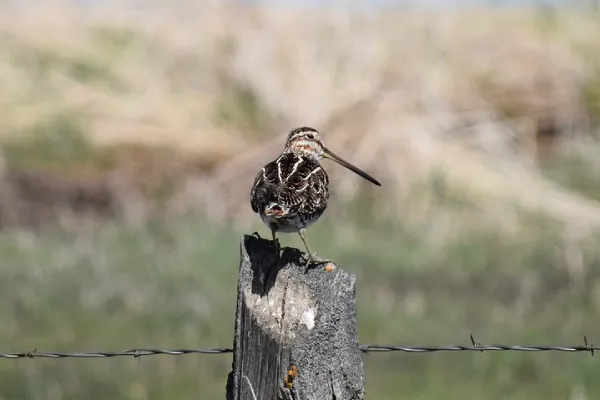
- Scientific Name: Gallinago delicata
Similar to American woodcocks, Wilson’s snipes are fond of wet grassy fields, sedge marshes, and bogs. These residents of Oklahoma are most commonly heard during dawn and dusk during winter.
To find them, listen for their “tuk-tuk” call from the ground or low perches.
Wilson’s Snipe Call | Source: Doug Hynes, CC BY-SA 4.0, via Wikimedia Commons
What’s fascinating is their winnowing display flight. Males fly high in circles and then take shallow dives to create a distinctive sound. You can witness this behavior during both day and nighttime.
Read More: What birds sing at night in Tennessee?
3. Eastern Screech-Owl

- Scientific Name: Megascops asio
Eastern screech owls are the most strictly nocturnal owls in North America.
They are permanent residents in Oklahoma and are commonly found in woodlands near water and at lower elevations, as well as urban areas. They are also one of the most numerous owls in the state.
They get chatty near sunset and go quieter as the night goes on. You’ll hear more calls during full moons and before storms. Listen for the “whinny” and trilling tremolo calls. In the summer (June to August), keep an ear out for juvenile hissing sounds.
Eastern Screech-owl Call | Source: Jonathon Jongsma, CC BY-SA 3.0, via Wikimedia Commons
4. Great Horned Owl

- Scientific Name: Bubo virginianus
Great horned owls are among Oklahoma’s largest birds, measuring nearly 2 feet in length and weighing up to 3.5 pounds. They’re year-round residents in the state.
These owls prefer open areas near mature forests, becoming most vocal an hour after dark and an hour before dawn. They are easiest to detect in December and January when they are establishing territories.
Their calls are deep and loud, sounding like “ho-ho-hoo hoo hoo,” with the female’s call being higher-pitched, peaking after midnight.
Great Horned Owl Call | Source: Michael & Katie LaTour, CC BY-SA 4.0, via Wikimedia Commons
In winter or spring, they may sing in duets. Territorial hooting decreases in February or March when they start laying eggs. In summer, the juvenile begging call can be confused with barn owls.
5. Barn Owl
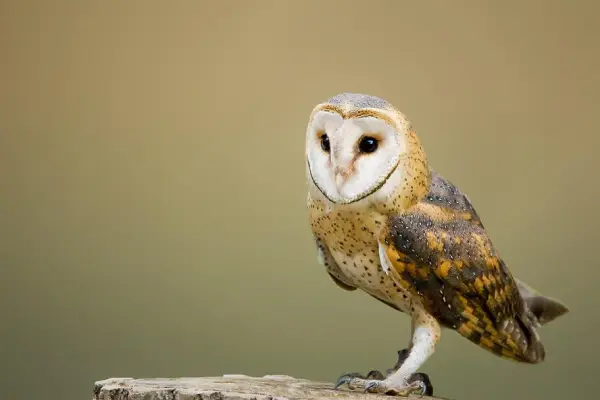
- Scientific Name: Tyto alba
Barn owls are permanent residents found throughout the state. Medium-sized with a “ghostly” appearance, they favor open habitats like grasslands, marshes, and agricultural areas.
Instead of hooting, barn owls emit bone-chilling screams during the night. They’re nocturnal hunters, preying on rodents, and take refuge in nest boxes, caves, tree hollows, and old buildings.
Barn Owl Call | Source: Luis Gracia, CC BY-SA 4.0, via Wikimedia Commons
Common across the USA, you can spot and hear these owls screaming at night in Alabama as well.
6. Barred Owl
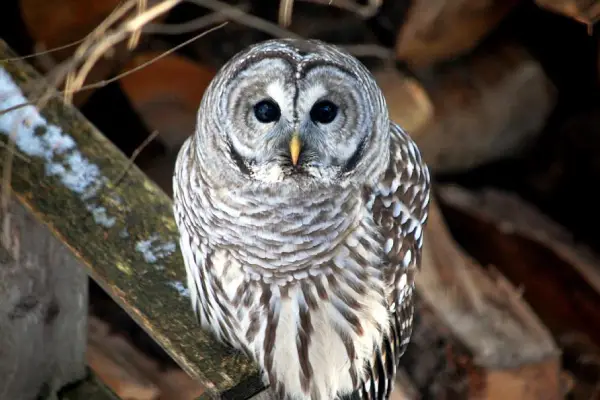
- Scientific Name: Strix varia
Barred owls are year-round residents of eastern parts of the state. They prefer dense deciduous or mixed forests near water, occurring also in suburban neighborhoods where sections of forest are still present.
They’re active throughout the night and are recognized by their distinctive “who-cooks-for-you” song and “hoo-ahhh” call. They often duet, and their juveniles make a high-pitched raspy hissing noise.
Barred Owl Song | Source: Jonathon Jongsma, CC BY-SA 4.0, via Wikimedia Commons
Can be also identified by their mottled brown and white plumage, yellow beaks, dark eyes, and lack of ear tufts.
7. Long-eared Owl
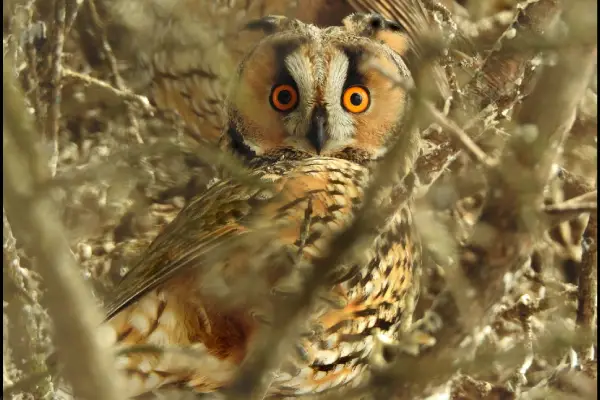
- Scientific Name: Asio otus
These elusive birds blend well into open forests, marshy areas, and dense coniferous woods of the state. Long-eared owls can be heard singing at night in Oklahoma during winter.
Very rare, they come alive shortly after dusk, remaining active throughout the night. These owls are generally quiet but make distinct calls. The male’s song resembles low-pitched “hoo” notes, like blowing across a bottle.
Long-eared Owl Call | Source: Alexander Kurthy, CC BY-SA 4.0, via Wikimedia Commons
They also have a distinctive juvenile begging call, though be cautious, as it can be confused with distant barking dogs or mooing cows.
Read More: Examples of Michigan’s nocturnal birds
8. Short-eared Owl

- Scientific Name: Asio flammeus
Short-eared owls are incredibly widespread, found on all continents except Antarctica and Australia. In winter, you can spot these nocturnal birds in open grasslands throughout the state, including weedy fields, small airport grass strips, coastal marshes, and agricultural fields with stubble.
They can be heard at night mostly from November to March, producing a series of “voo-hoo-hoo” calls.
These owls are mainly nocturnal hunters but can also be crepuscular (active near dawn and dusk) and even diurnal, though less frequently.
Short-eared Owl Call | Source: Jamescandless, CC BY-SA 3.0, via Wikimedia Commons
9. Pied-billed Grebe

- Scientific Name: Podilymbus podiceps
Pied-billed grebes are small, stocky water birds with brown plumage that provides excellent camouflage. They are permanent residents found around large bodies of water across the state.
These grebes prefer marshes and ponds with emergent vegetation, staying active throughout the night. Look out for their loud, whooping, cuckoo-like song, and sometimes, pairs singing together in a duet.
Read More: List of birds chirping at night in South Carolina
10. Common Nighthawk

- Scientific Name: Chordeiles minor
Common nighthawks are medium-sized birds of Oklahoma, active during dawn and dusk with a visible moon. They make a distinct “peent” sound and perform courtship displays with rapid dives, creating a booming sound.
Common Nighthawk Call | Source: Unknown author, Public domain, via Wikimedia Commons
These summer residents are found in prairies, forests, savannahs, and urban areas. During the day, they’re well-camouflaged with gray, black, and brown plumage with white wing patches.
11. Chuck-will’s-widow
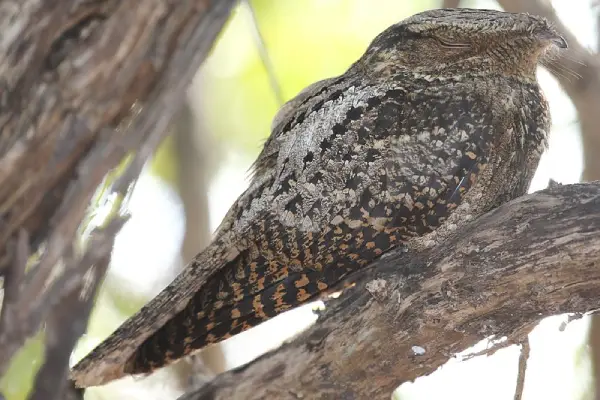
- Scientific Name: Antrostomus carolinensis
Chuck-will’s-widows are large night birds with big heads, short bills, and long tails. Their plumage varies from grayish to rufous, helping them blend into trees.
They’re often found in pine barrens and swamp edges, known for their “chuck-will’s-widow” songs. Males are most vocal in April-May, quieter in June, and back to singing in July and August. Singing can continue all night during a full or near-full moon.
Chuck-will’s-widow Call | Source: James G. Howes, Public domain, via Wikimedia Commons
You might have seen them while driving at night as they like sitting on roads and roadsides, watching for flying insects. They are fairly common summer residents in middle and east Oklahoma.
12. Eastern Whip-poor-will
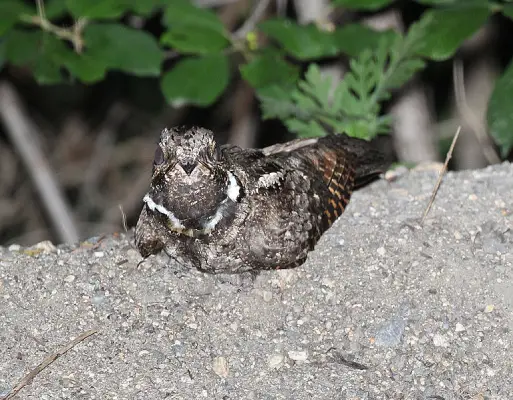
- Scientific Name: Antrostomus vociferus
Eastern whip-poor-wills can be heard after dusk and before dawn during the late spring and early summer nights in Eastern Oklahoma.
These cryptic nocturnal birds are more often heard than seen, staying still during the day. They’re found in pine barrens and forest openings, singing their “whip-poor-will” song at dawn and dusk.
Eastern whip-poor-will Call | Source: G. McGrane, Public domain, via Wikimedia Commons
They hunt at night, catching flying insects from the ground. While they resemble common nighthawks, their behavior and characteristic call set them apart.
13. Ovenbird
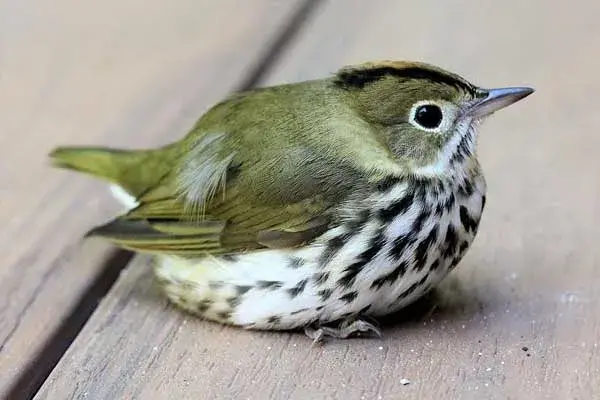
- Scientific name: Seiurus aurocapilla
Ovenbirds sing regularly at night but at a relatively low song rate. These small migratory songbirds can be heard in the easternmost parts of the state.
Lister for their territorial rapid, resounding “tea-cher, tea-cher” song consisting of 8-13 phrases. Ovenbirds also have several short calls, including the “ple-bleep,” “whink,” and high “tsip.”
Ovenbird Song | Source: G McGrane, Public domain, via Wikimedia Commons
Ovenbirds got their name from the nest they built called the “oven” – it is a dome-like structure placed on the ground with a side entrance that makes it resemble a Dutch oven.
Read More: List of Ohio’s nocturnal birds
14. American Coot
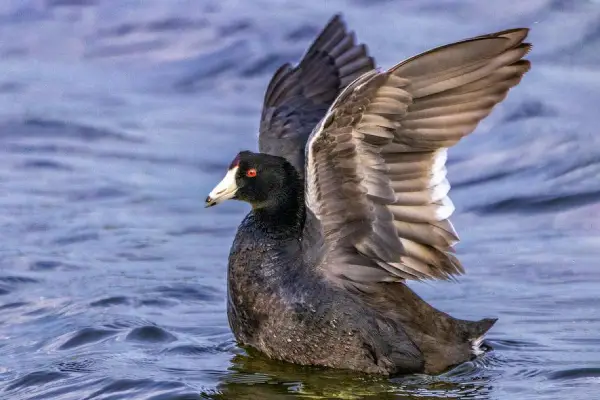
- Scientific Name: Fulica americana
American hoots can be heard in Oklahoma year-round, mostly around dawn and dusk.
Despite resembling ducks, American coots are only distantly related. You can spot and hear them in freshwater wetlands with open water and emergent vegetation.
Listen for their sharp “poot” call and screeching “kree” sound, and notice their noisy swimming, often followed by splashing water sounds.
Read More: What are some common nocturnal birds from Florida?
15. White-throated Sparrow

- Scientific name: Zonotrichia albicollis
White-throated sparrows are passerine birds with striking head patterns. These sparrows come in two variations: tan-striped and white-striped. White-striped sparrows are more aggressive than tan-striped ones, and each bird will always mate with a bird of opposite stripe color.
White-throated sparrows are one of several birds that chirp at night. They migrate mostly at night and have two songs. The first goes high, while the second goes low, and people describe it as “Po-or Sam Peabody, Peabody, Peabody” or “O-oh sweet Canada, Canada, Canada.”
Read More: List of night birds heard in Indiana
16. Black-crowned Night Heron
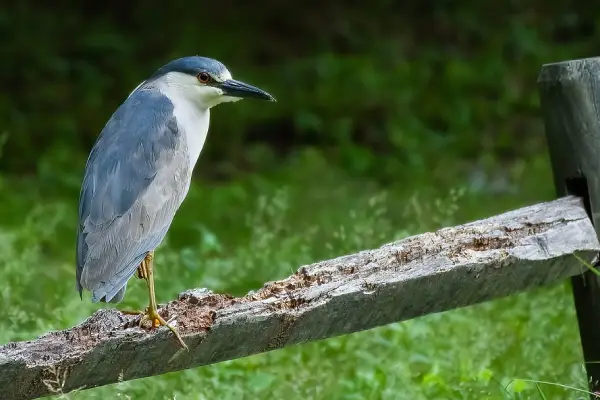
- Scientific Name: Nycticorax nycticorax
Black-crowned night herons are common nesting species throughout Oklahoma. They can be seen around wooded swamps, ponds, lakes, and mangroves.
Unlike most herons, they are most active at night or at dusk. They often bait fish by tossing food in the water to lure prey before striking with their long beaks.
These nocturnal and noisy herons migrate in large night flocks. Their scientific name “Nycticorax” comes from the ancient Greek term meaning “night raven,” referring to their nocturnal feeding habits and crow-like calls.
Black-crowned Night Heron Call | Source: Jonathon Jongsma, CC BY-SA 3.0, via Wikimedia Commons
Read More: What birds sing at night in Oregon?
17. Yellow-crowned Night Heron

- Scientific Name: Nyctanassa violacea
Yellow-crowned night-herons can be heard at dusk, dawn, and during the night. They’re named after the pale yellow crowns on their heads.
These large blue birds are vocal, making various sounds. Their common alarm call is a sharp “quawk.” During courtship, males and females may also use “yup-yup” and “huh” calls.
They are strictly nocturnal and feed at night, primarily on crabs and crayfish.
Read More: Common nocturnal birds of Georgia
18. Northern Mockingbird

- Scientific name: Mimus polyglottos
Northern mockingbirds are the most commonly heard at night in Oklahoma, with the nighttime singers often being young, unattached males or older males without mates. In well-lit areas, even mated males may sing at night.
To reduce their constant (and obnoxious) singing, you can use bird nets on trees or set up cardboard cutouts of predators like hawks or owls.
These birds are year-round residents in the state, and their translated Latin name, “many-tongued mimic,” is well-deserved. They can imitate over 35 species and learn more than 200 songs in their lifetime!
Their mimicry extends to sounds like rusty hinges, car alarms, cackling hens, and dog barks, often indistinguishable from the real thing.
Northern Mockingbird Song | Source: Sandtouch Limited Company, a Texas limited liability company, CC BY 3.0, via Wikimedia Commons
Read More: Examples of most common night singers in Texas
19. Yellow-breasted Chat

- Scientific Name: Icteria virens
Found and heard across all of Oklahoma, yellow-breasted chats are one of the few songbirds that will frequently sing at night. They migrate to Mexico and Central America in winter but can be heard during the summer breeding season in the state.
They’re often heard more than seen and frequent dense, brushy areas and hedgerows. Their songs feature a unique mix of cackles, clucks, whistles, hoots, and harsh “chak” calls.
Yellow-breasted Chat Song | Source: Jonathon Jongsma, CC BY-SA 4.0, via Wikimedia Commons
Yellow-breasted chats can mimic other birds, sometimes causing confusion. During the breeding season, they become more conspicuous, singing from exposed spots and flying openly while gurgling their songs.
Read More: What birds sing at night in North Carolina?
20. American Robin

- Scientific name: Turdus migratorius
American robins, common songbirds in Oklahoma year-round, are often found in forests, lawns, and suburbs across the state.
As winter turns to spring and daylight grows, they earn the nickname “wake robins” for being among the first birds heard at dawn. Their song is a “cheery” carol, a series of clear whistles, along with a sharp “yeep” alarm call and a mumbled “tuk” for communication.
American Robin Song | Source: G. McGrane, Public domain, via Wikimedia Commons
At sunset, their song shifts, adding soft, almost whispered notes, creating an elegant and intricate evening melody.
Read More: What birds sing at night in Missouri?
What Birds Sing At Night In Oklahoma?
The most common birds that sing at night in Oklahoma are Northern mockingbirds.
Mockingbirds singing all night are often young, unattached males or older males without a mate. In case you want to stop their nighttime singing, try to cover your tree with bird netting or add an owl/hawk cardboard cutout to scare them away.
You might have also heard yellow-breasted chats singing in the darkness as they call out to the females, American robins and their cheery carol, or even barn owls and their bone-chilling screams.
Summary
Oklahoma boasts a diverse collection of nocturnal birds, with some, such as various owl species and northern mockingbirds, being year-round residents, while others, like yellow-breasted chats and common nighthawks, making seasonal visits to the state for breeding.
If you’ve encountered or heard any of these birds, we trust this guide has been useful in identifying them.
Feel free to read our other popular articles on night birds heard in New York and night birds heard in Louisiana